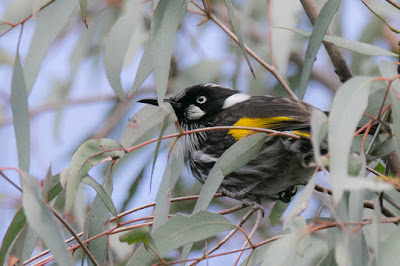New Holland Honeyeater Phylidonyris novaechollandiae
Whilst
waiting for the train at Kilmore East railway station, there are many
birds to be seen, flitting in and out of the numerous native plants
between the station platform and the car-park.
There are numerous sparrows. They seem to centred around the old railway buildings where they have nests in the roof spaces. Magpies, rosellas, pardalotes, cockatoos, blackbirds, wattle-birds, currawongs, and wrens. The birds which attracts me most are the New Holland Honeyeaters.
They are a common bird in the Kilmore area. However they seem to maintain a small area of occupation. Kilmore is still a reasonably small town but there are places where these honeyeaters are rarely seen. Where I live I never see them. If I cross to some of the newer estates, just a kilometre away, where native gardens are more the fashion, New Holland Eaters are common. Perhaps there are too many roses, camellias, daffodils and other old world plants. Not too attractive to the honeyeaters.
We old garden dwellers of Kilmore need to put in more and more native plants to feed these beautiful and lively visitors. Beautiful and lively they may be, but they can be very aggressive towards other birds. They can be often seen chasing the wrens and parrots away from their patch.
This morning I could see a number of birds chasing each other between the bushes, as they all seem to do at this time of the year. But amongst them were adult birds with young ones. The young ones have a darker eye than the adults, a pale brown colour, Adults have a startling white eye. A vivid white surrounding a very black pupil. They always seem to be looking at you.





No comments:
Post a Comment